|
1ST PRIZE
A03T30
Name and Surname of the Participant/s behind the TeamID > Tamara Ivanova, Angela Petrovska
Institution/School of Architecture >
Faculty of Architecture, Ss. Cyril and Methodius University - Skopje;
Politecnico di Milano
Year of Studies > fourth
City > Skopje
Country > North Macedonia
|
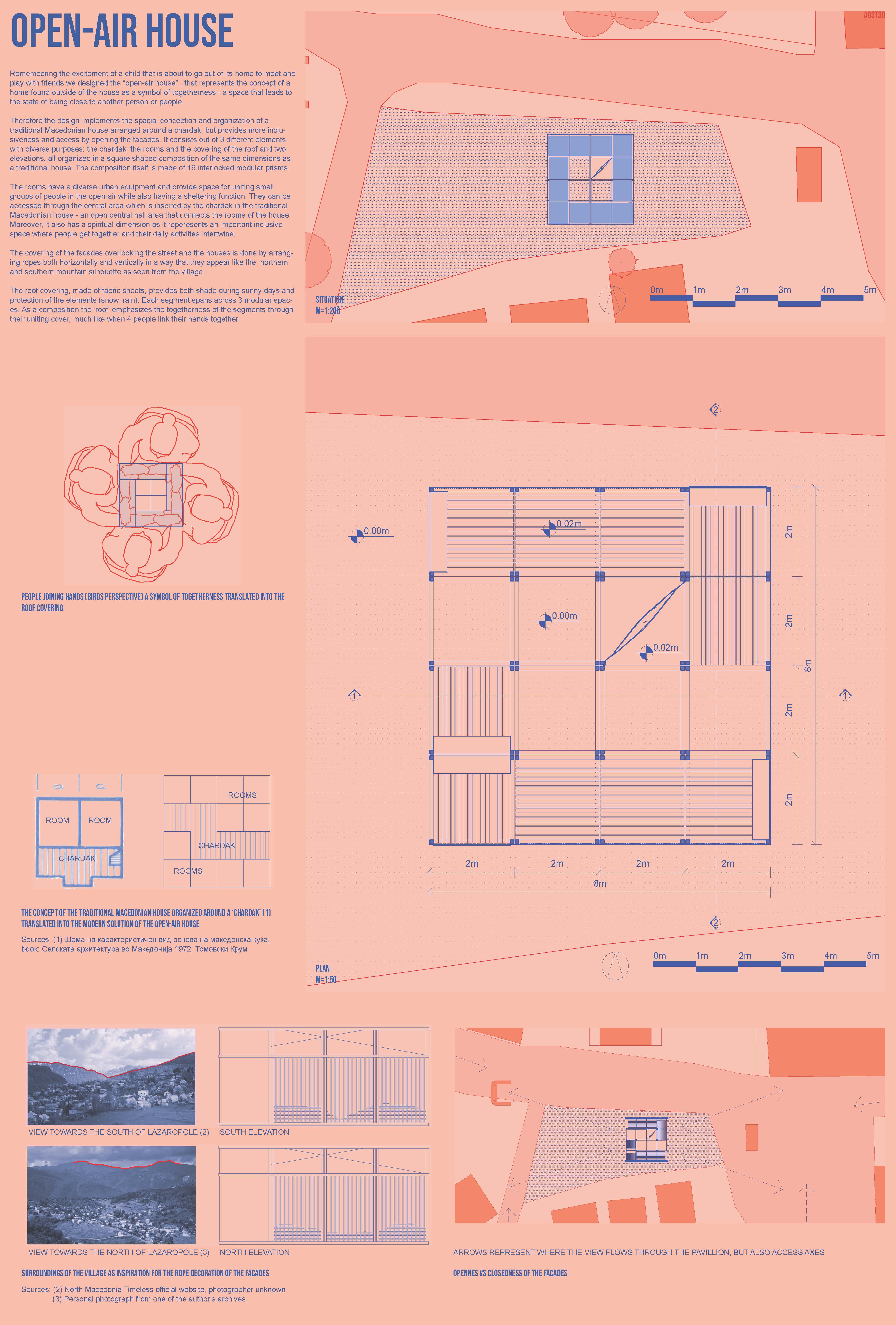 |
OPEN AIR HOUSE
In the words of its authors, they conceptualized an “open-air house” that represents the concept of a home found outside, as a symbol of togetherness.
The design is based upon a quadrant divided in 16 fields (2m x 2m) that absorbs the translation of the elements of traditional house in a public pavilion-type architecture consisted of rooms, “chardak” and the covering of the roof.
The “chardak” area as a common space is positioned in the middle part and opened for entrance on two sides, west and east, following the direction of the existing street. It functions as an open central hall, an important spatial knot that connects the rooms configurationally and enables intertwining of all inhabitants’ daily activities as an inclusive spot of getting together.
The rooms provide space for uniting small groups of people in the open-air while also having a sheltering function. The space is equipped with less-defined, evocative elements that spark (in users) various ideas for appropriation.
The whole is materialized as a modular wooden structure, completely opened on two sides to frame the visual fields towards the existing “piazza” in front of Kalin Hotel on the east and the public faucet, the traditional houses and the church of St. George on the west side, and partially closed on the south and north side towards the existing residential houses and the street.
The south and north facades are characterized with the pattern of horizontally and vertically interwoven rope that is inspired by northern and southern mountain silhouette as seen from the village. Although this literal analogy is questionable, the Jury however thinks that the effect of “low-tech” hand-crafted porous membranes made out of ropes is creative solution.
The presentation of the project is conducted as complete and mature technical illustration and 3d visualizations with meticulously chosen color pallet, scenario montages and contextual relevance of the design. |
| 2ND PRIZE
JCNTH7
Name and Surname of the Participant/s behind the TeamID > Aleksandra Cvetkovska
Institution/School of Architecture > Faculty of Architecture, Ss. Cyril and Methodius University - Skopje
Year of Studies > second
City > Skopje
Country > North Macedonia
|
 |
SEE-THROUGH REDDISH WOODEN STRUCTURE
This project focuses on the rituals of eating and playing as natural instigators of socialization and inherent patterns of togetherness. It consists out of climbing platforms - a structure that calls for an active exploration of the space and offers a free choice of meeting points and an eating stall which, through the actions of its users, is turned into a big dining room and kitchen for the entire local center of Lazaropole. The roof of the eating stall functions as an additional deck, conceived as an elevated porch of the local houses. It is meant to encourage various interactions through age-old activities that bond people together like preparing and sharing a meal, playing and enjoying the vista of one’s hometown.
The association that comes to mind when looking at this project is a children's playground. The authors elaborate their idea very well, saying that they are inspired by a playground’s capacity for informal socialization.
The project is based upon the formal strategy of manipulating the stepping platforms, which are combined into a see-through wooden structure that does not have the ambition to represent a solid architectural object, but a hybrid element that triggers different situations/scenarios of togetherness.
These stepping platforms extend and transform in order to enable the programmatic essence of climbing, seating, eating and enjoying the beautiful vista of the village church with the surrounding houses through a tripartite, yet indivisible composition of an eating stall, a porch and a tower.
The architectural representations consisted of the reddish structure that stands out in the contrast of the yellow grass and the black and white scenography of events of togetherness are both provocative and evocative, leaving space to simultaneously contemplate the architectural idea independently and in the context of the topic on togetherness. However, the Jury discussed the shortcomings of the architectural articulation of the idea related to the scale and the detailing of the proposed solution, presuming that the authors are very young students. |
| 3RD PRIZE
Ld9894
Name and Surname of the Participant/s behind the TeamID > Lidija Pranjić, Dylan Jacco Quinten Gubbels
Institution/School of Architecture > Faculty of Architecture, University of Ljubljana
Year of Studies > EM Arhitektura (2. stopnja) 3rd year, MAG Urbanizem (2. stopnja) 1st year
City > Ljubljana
Country > Slovenia
|
 |
THE OASIS OF PEACE AND TOGETHERNESS
The project is evaluated as a very realistic one, based upon “down to earth” rational decisions that lead towards strong sensibility in accordance with the everyday-ness value of the location site.
It is a design proposal for of new public space instead of pavilion structure that accentuates the directions of walking and viewing focuses on the axis of west-east, where instead of using the main street in the full sun, an alternative of green islands titled “oasis of peace and togetherness” is created.
The design is based upon a formal strategy of twisted curve between the existing bakery and the public faucet along which new urban elements with various programmatic possibilities are inserted. The scale of the proposed urban elements varies between the scale of urban equipment and the scale of architectural object. They form inconspicuousborder lines on the north and south to provide a safe and green pedestrian zone in-between the existing street and the residential houses.
The programme consists out of a plaza in the east side and a grill cove in the west. It is a casual place, for coming, sitting and eating together whilst enjoying the sun or the shade of the trees. The narrative that follows the drawings is consistent to this concept of casualness and everyday-ness: “During the day, people can sit down with fresh baked bread from the existing bakery, bordering the east side of the area…” The authors plan to have fruit trees on the eastern edge of the location site that will provide free fruits for all the visitors in the future.
The architectural representation is simple, consistent to the standpoints it communicates and technically mature.
|
|
TOP #5
HONORABLE MENTION
ML820J
Name and Surname of the Participant/s behind the TeamID >
Lucas Escudero Arnés, Martina Blázquez Polaina
Institution/School of Architecture >
La Salle Campus Barcelona - Ramon Llull
Year of Studies > third
City > Barcelona
Country > Spain
|
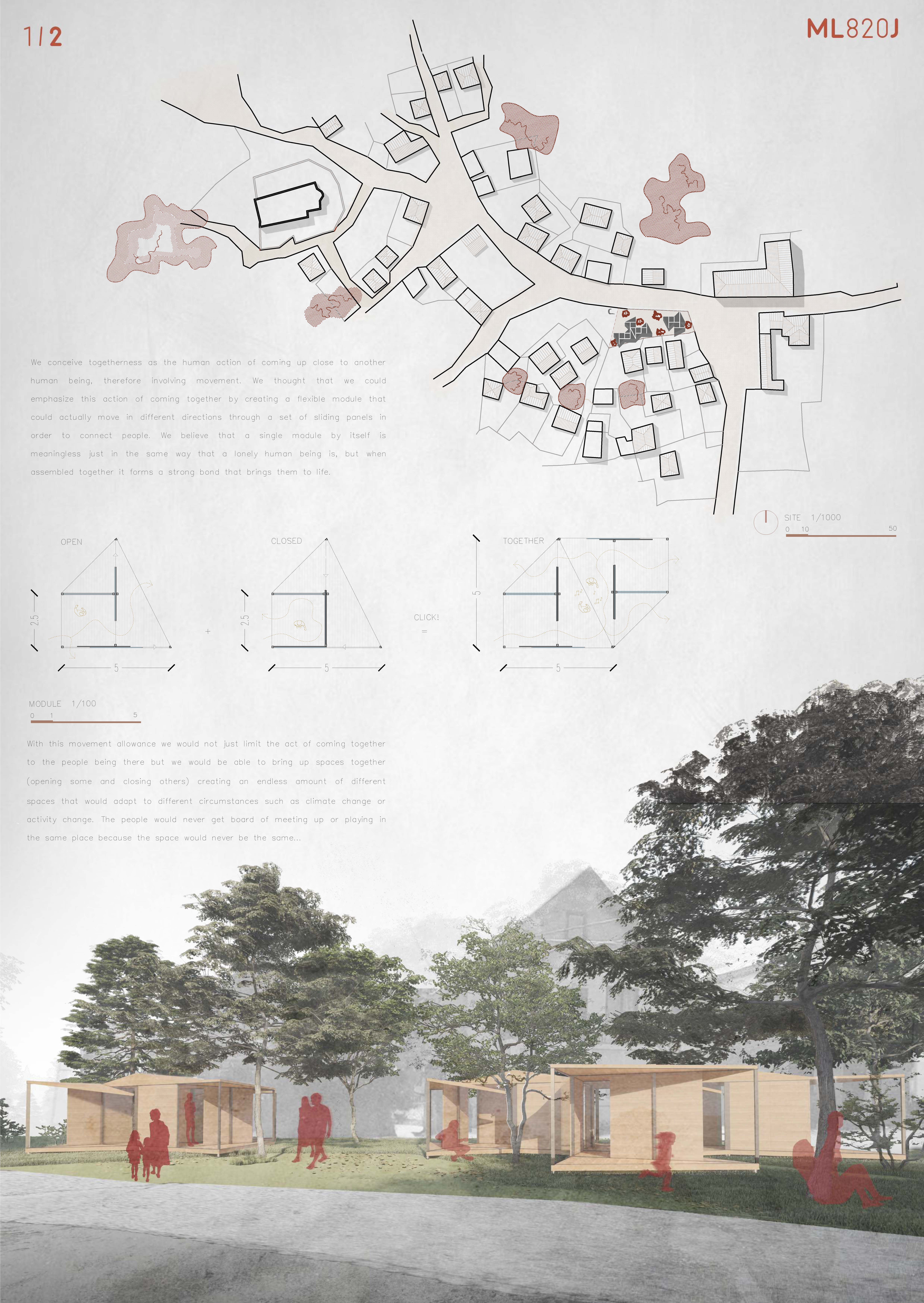 |
SOCIAL FOREST
Inspired by etymological definition of Lazaropole meaning “large area without forest”, the authors came up with an idea of “planting” a social forest out of a vernacular-like single module that was further architecturally developed in a growing scenario. The basic module is 2.5/2.5 meters, with two variations of diagonally cut basic modules that through a set of sliding panels can create ever-changing passages, openings and closures of spaces when assembled.
The planned program is very ambitious, and distributed in three zones, of which the first one is dedicated to artistic practices (exhibitions, museum and library activities), the second one to open area activities (traditional dances, open cinema, open air dining) and the third one to educative activities (nature school/kindergarten, workshops etc.) The Jury however questions if the programmatic scenarios are architecturally articulated enough.
The Jury highly appreciates the overall composition according to the location site, the formal outcome of “regular irregularity” and the scale of the proposed structure. The permeability of open and closed spaces that enables casual coexistence of nature, people and architecture is praiseworthy quality. The Jury also underlines the technical maturity of the architectural representation. |
|
TOP #5
HONORABLE MENTION
3946aj
Name and Surname of the Participant/s behind the TeamID >Tarif Araf, Jakiat Jitu
Institution/School of Architecture > Bangladesh University of Engineering and Technology
Year of Studies > fourth
City >Dhaka
Country >Bangladesh
|
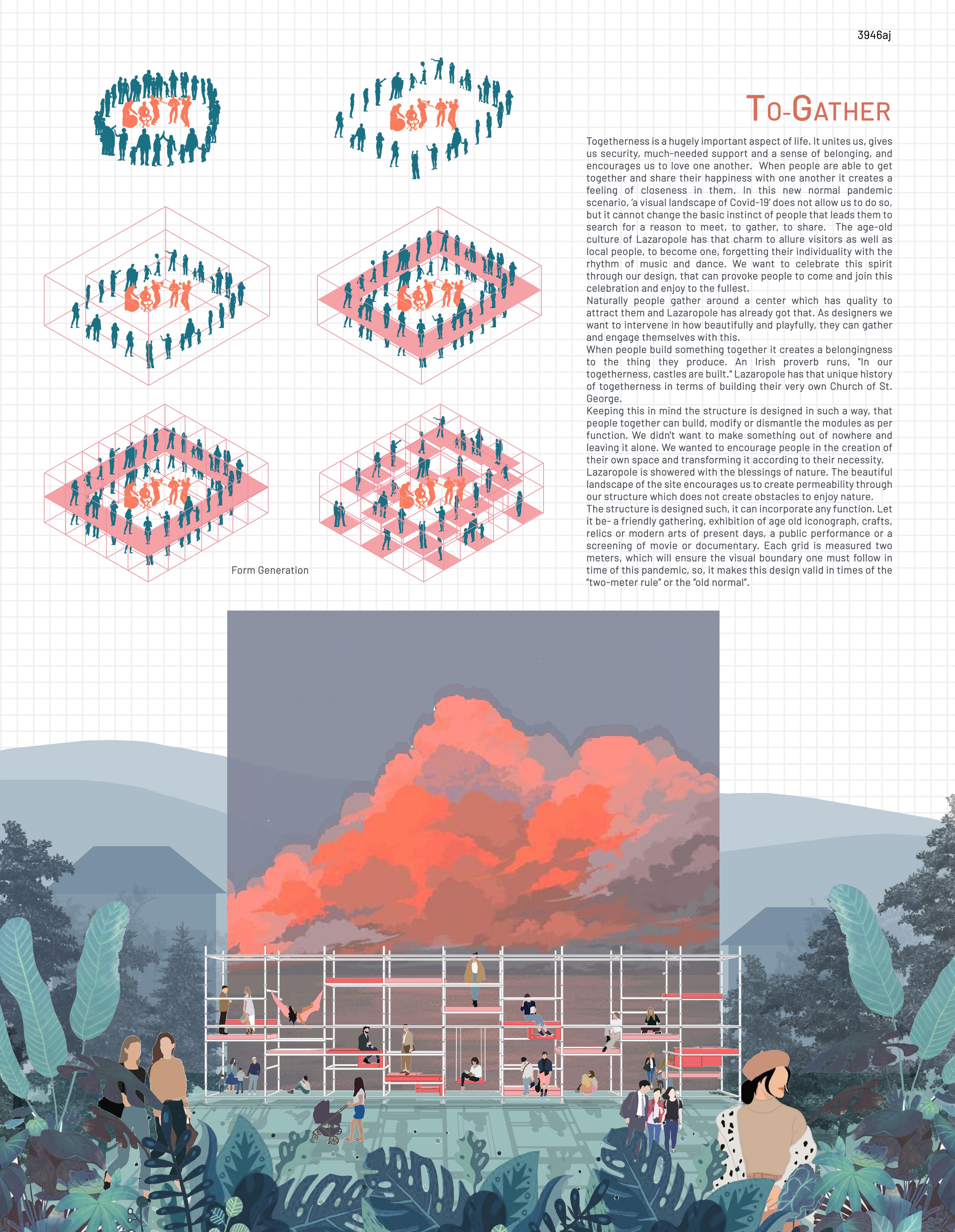 |
TO-GATHER
“In our togetherness, castles are built.” - authors state in their panels a famous Irish proverb.
The project is conceptualized around a spatial grid - planks and railings and modules – purple elements that resemble newly designed scaffolding that can be easily manipulated by its users in order to support multiple programmatic scenarios in a centric configuration.
It is inspired, in the words of its authors, by Lazaropole’s historical story on togetherness about the Church of St. George that was built with participation of every citizen.
All of the Jury members praised both the project’s idea and its representation.
Although the juxtaposition of contemporaneity and the tradition is a prevailing theme in the visual presentation, an idea about further and more sensitive usage of this “scaffolding” was discussed by some of the Jury members: instead of pretentious display of orthodox icons as contemporary exhibition, the “scaffolding” itself could be wrapped around some real artifacts from Lazaropole to enable a close-up examination and an authentic experience of traditional values in situ. This discussion therefore questioned the definite position of the structure within the location site and the centric configuration that actually limits other unforeseen possibilities.
Despite the scaffolding idea being exhausted in many recent architectural projects, it is however a very curious architectural product, a frame for opening the context of architecture and Lazaropole towards contemporary collaborative and participative artistic practices. |
| TOP #10
HONORABLE MENTION
teamarch111
Name and Surname of the Participant/s behind the TeamID > Eva Kosteska, Viktorija Mojsovska
Institution/School of Architecture > Faculty of Architecture, Ss. Cyril and Methodius University - Skopje
Year of Studies > third
City > Skopje
Country > North Macedonia
|
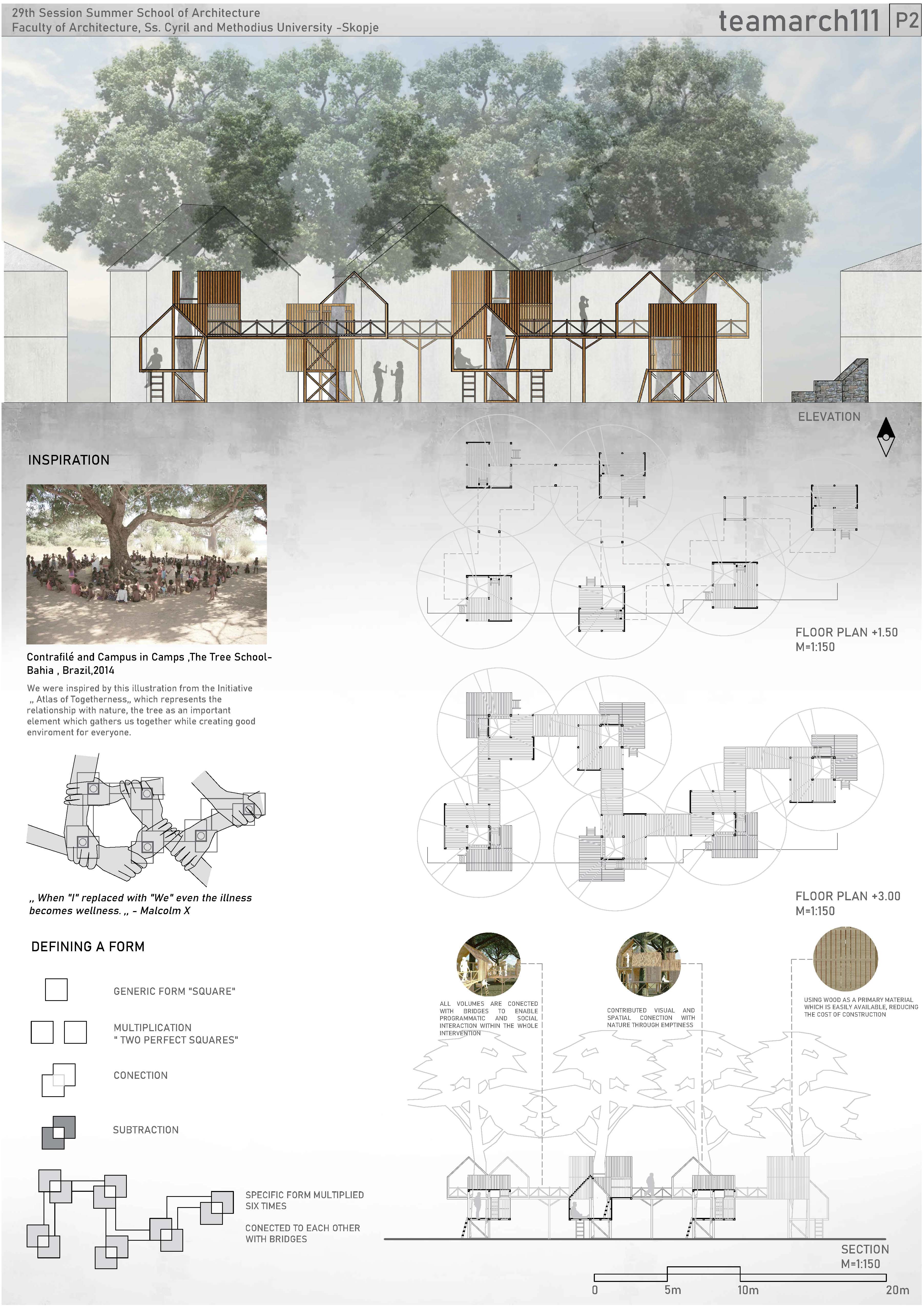 |
THE TREE HOUSE DREAM
The project is based upon authors’ personal association on togetherness, assemblage of six/twelve single tree houses.
The tree house is an epitome of childhood, both as dreamy imaginative construction when longed, and as safe shelter architecturally well-defined when possessed. As singular tree house, it associates children’s freedom of creative imagination and adventures, a coexistence with nature and closeness to the sky, and first independence from the adult world.
What does this image of multiplied tree houses represent when put in the middle of our pandemic adult world? Is it a direct reflection of authors’ inner longing for “stepping on a break”, for slowing down, for reconnecting with nature, for giving time to creativity and space for coexistence in peace and serenity? Almost as a childhood dream.
It is so desirable and at the same time as impossible as the trees these houses grow around (that are non-existent). Yet again it can be so simple and possible as the act of planting the trees over the years and building of the tree houses together, while waiting for the better world to arise.
The Jury underlines the technical maturity of the architectural representation. |
| TOP #10
HONORABLE MENTION
HEARTHESS56
Name and Surname of the Participant/s behind the TeamID > Bojana Stankovska, Pale Janeva
Institution/School of Architecture > Faculty of Architecture, Ss. Cyril and Methodius University - Skopje
Year of Studies > second, pre-graduate
City > Skopje
Country > North Macedonia
|
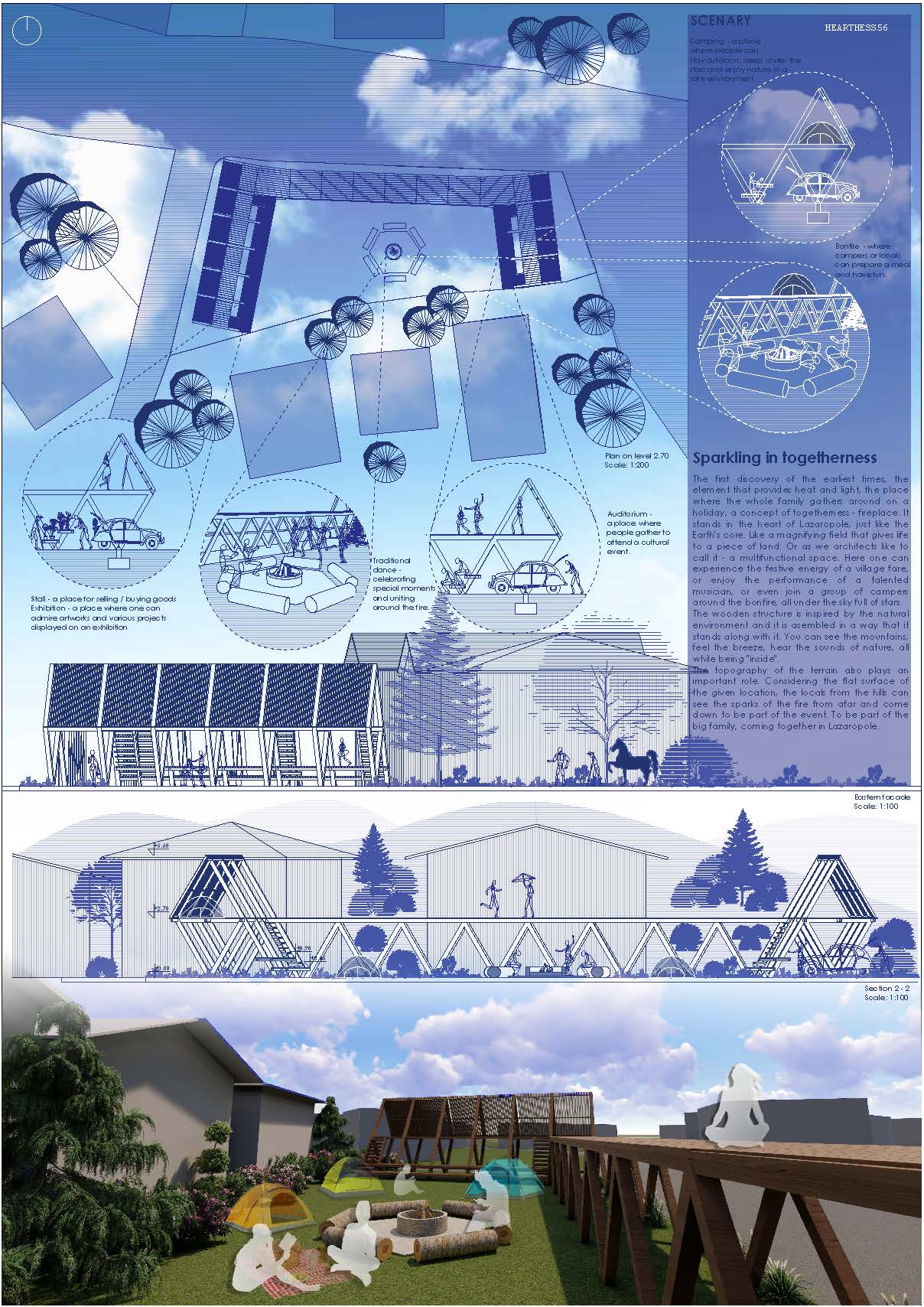 |
THE ZIG ZAG AGORA
The project follows the existing conditions of the location site as the need for seasonal parking and keeping residential houses’ open views on the south edge of the location site. It then marks a strong center with a public fireplace, a beginning of the future “agora” and further formalizes it through a linear gesture that asserts the perimeter of the site. The linear gesture opens on the north side to form a “portal” and is structured by zig-zag wooden elements that grow into rhomboids on east and west side of the agora.
The Jury highly evaluates the singularity of the concept that through a single gesture unites the programmatic possibilities (camping around fire, traditional dances and other cultural activities in the center, exhibitions in the perimeter, watching the stars at night etc.) and the strong formal identity that creates a new mezzanine in the village of Lazaropole where you see and are observed by others. The Jury underlines the technical maturity of the architectural representations, but discussed the incompatibility between the 2d and 3d representations of the project, with the latter being characterized as uncritical excess. The Jury also highly evaluates the convincing depiction and possibility for experiencing the festive energy of a village fare.
|
| TOP #10
HONORABLE MENTION
BING4301
Name and Surname of the Participant/s behind the TeamID > Jordan Lazoroski, Oliver Dalcheski
Institution/School of Architecture > Faculty of Architecture, Ss. Cyril and Methodius University - Skopje
Year of Studies > pre-graduate
City > Skopje
Country > North Macedonia
|
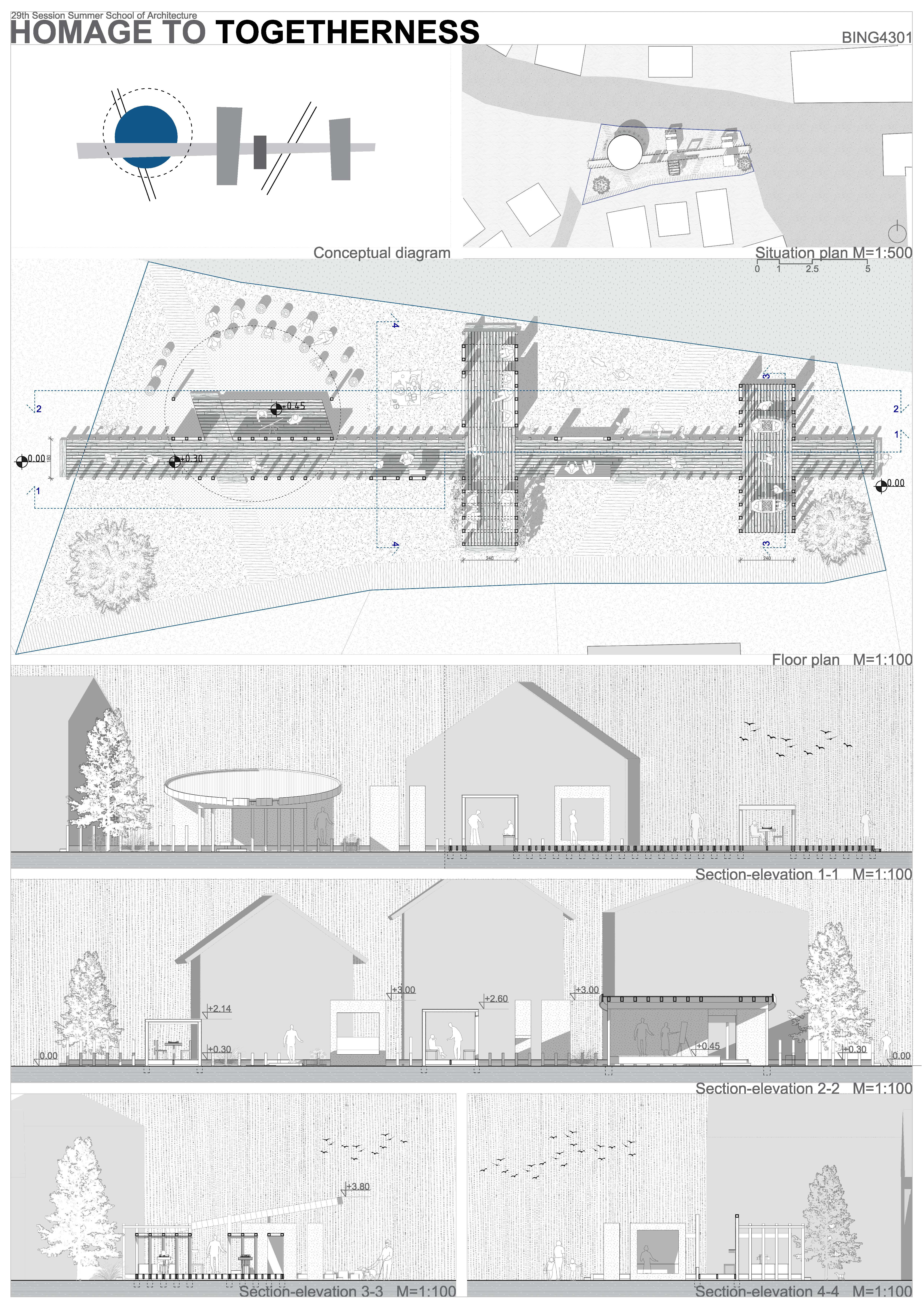 |
STRUCTURALIST INTUITION
The project represents interesting ambition to test the formal outcome out of combining axial lines that encourage movements through the location and basic geometric shapes/typologies in the intersecting points of the axes that situate different types of interaction (intimate/private interaction, semi-private and public interaction). The solution is inspired by authors’ observations on how different types of communities manifest different forms of informal gatherings, for which the Jury believes should be further elaborated.
There is particular conflict between the ambition to invent a formal structure that situates particular types of interactions and the elaboration of the programme as functional outcome of different furniture typologies that enable eating, playing chess, sitting on a bench etc.
However, the 3d visualizations speak of a very vibrantly imagined situation of togetherness with great possibilities enabled by the structural elements consisting out of primary and secondary axis, geometric typologies that intersect them, secluded areas along the secondary axis, exposed areas along the primary axis, rhythm of frames as stop-points, the circle as geometry of the collective etc.
Despite the shortcoming of the elaboration, the Jury underlines the great intuition behind this concept and praises the authors’ committed work.
|
TOP #10
HONORABLE MENTION
MO2SFT
Name and Surname of the Participant/s behind the TeamID > Maja Petrevska, Mila Gavrilovska
Institution/School of Architecture > Faculty of Architecture, Ss. Cyril and Methodius University - Skopje
Year of Studies > second
City > Skopje
Country > North Macedonia
|
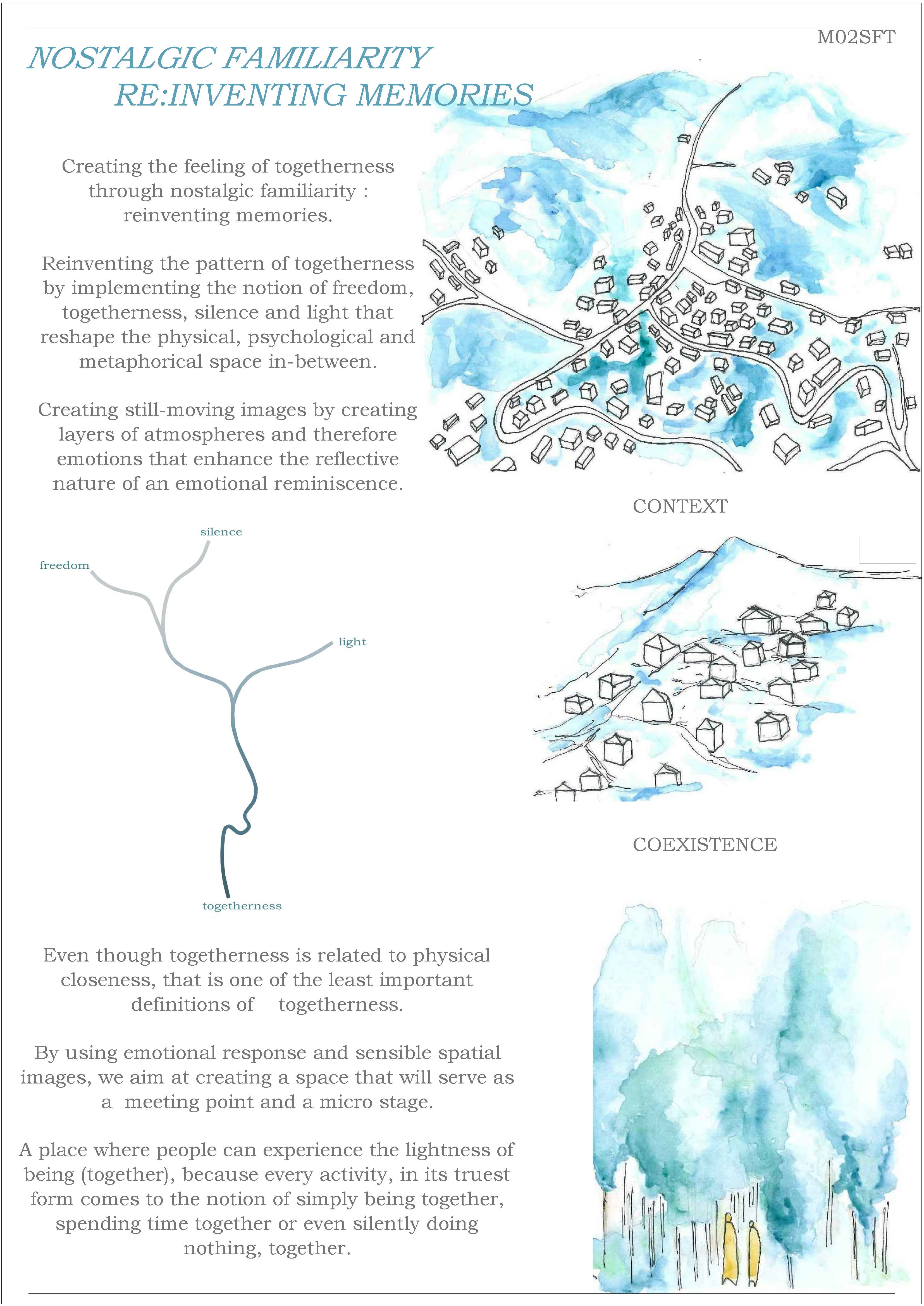 |
NOSTALGIC FAMILIARITY RE:INVENTING MEMORIES
“Even though togetherness is related to physical closeness, that is one of the least important definitions of togetherness.” – authors state bravely in the elaboration of their idea. The authors propose a reinvention of the pattern of togetherness by implementing the notion of freedom (to silently doing nothing together), silence, light and scent as conceptual elements of the new architectural situation of togetherness.
Togetherness is as simple and as complex as the form of a circle, they claim, so the design represents a simple gesture of encircling and further uses the nature to finish it, in a kind of a process oriented approach that almost ritually gives homage to one situation of togetherness. Authors add small trees around the open pavilion to intensify the game of shadows and light, and they also add lavender plants to stimulate an unconscious association between the smell of lavender and the notion of togetherness, to build memory on togetherness through a scent.
How does togetherness smell like as a persistent memory is a curious question that is asked through this project. However, the Jury questioned the choice of the lavender as the scent of togetherness and its relation to the Lazaropole genius loci.
The Jury highly evaluates the unique sensibility regarding the notion of togetherness, expressed also through the aquarellist representations. |
| TOP #10
HONORABLE MENTION
HOUSE7
Name and Surname of the Participant/s behind the TeamID > Kalina Trajanovska, Giuseppina Verduci
Institution/School of Architecture >
Faculty of Architecture, Ss. Cyril and Methodius University – Skopje
Faculty of Architecture at Mediterranea University of Reggio Calabria
Year of Studies > forth, pre-graduate
City > Skopje; Reggio Calabria
Country > North Macedonia, Italy
|
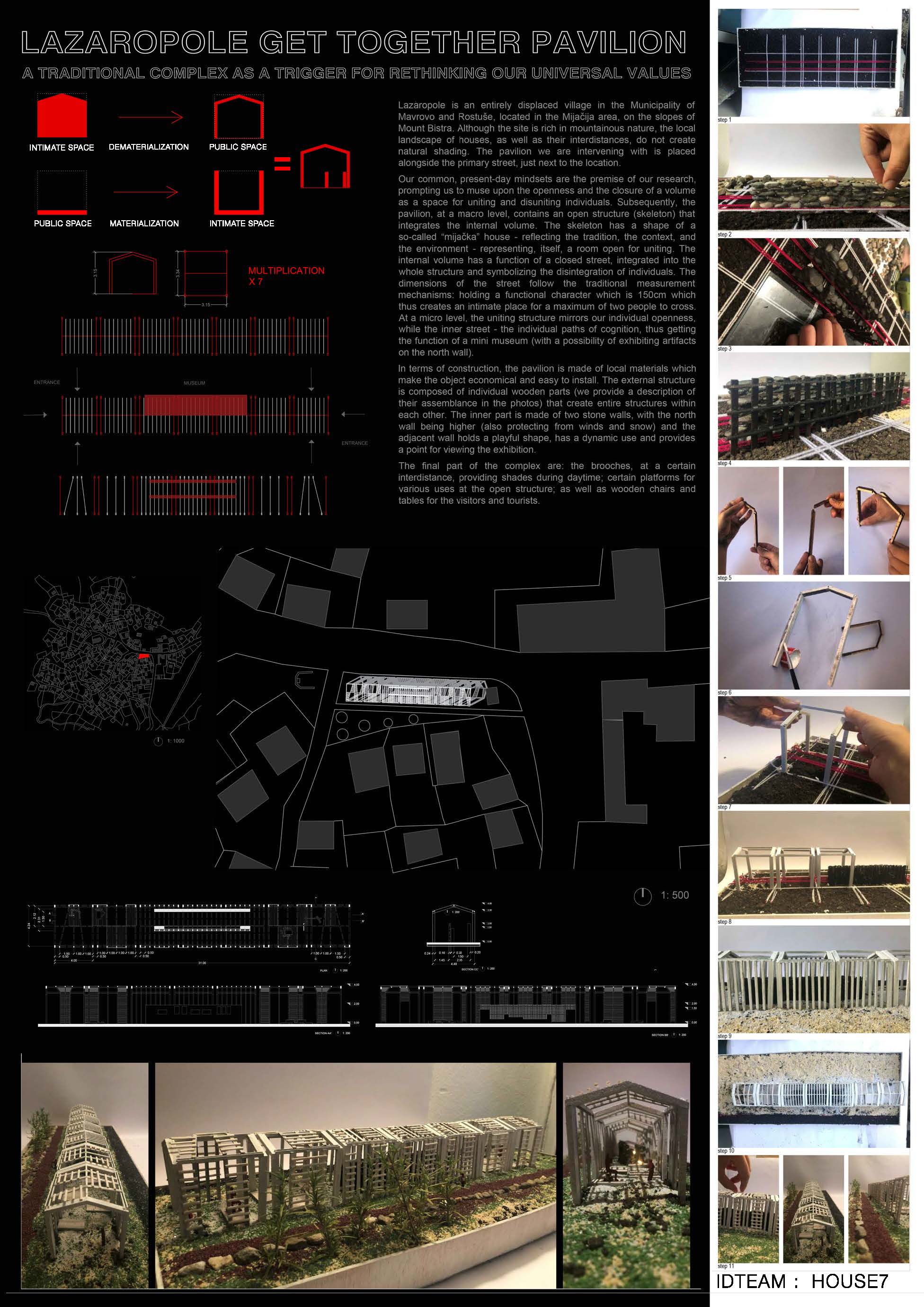 |
LAZAROPOLE GET-TOGETHER PAVILLION/A TRADITIONAL COMPLEX FOR RETHINKING OUR UNIVERSAL VALUES
The project is positioned alongside of the primary street, as its atmospheric pedestrian alternative, an architecture that compensates the lack of natural shading in the area.
The formal strategy used is based upon the concept of “structure within a structure”, an outer “skeleton” open for public experience and a hidden street/miniature museum dedicated to an intimate inner experience.
The Jury discussed that it resembles the local temporary structures serving the agricultural needs and questioned which are the steppingstones of the design. Several scenarios were discussed as potential development of the basic idea, as architectural elaboration of the vegetative character of the location site around and within the project that is seen on the photos but not explained, possible phasing of the atmospheres as passing through the “cinematic structure”, etc.
The Jury especially values the author’s process of design based upon a hand-made model, that meticulous and detailed as it is, is in itself homage to (believe in) togetherness. According to the persuasiveness and authenticity of the presentation, it is uniquely conceptualized around phasing photography of the hand-made model with accentuation of the materiality and tactility that adds to the overall concept of the traditional craftsmanship and the aim towards a real physical and spatial encounter. |